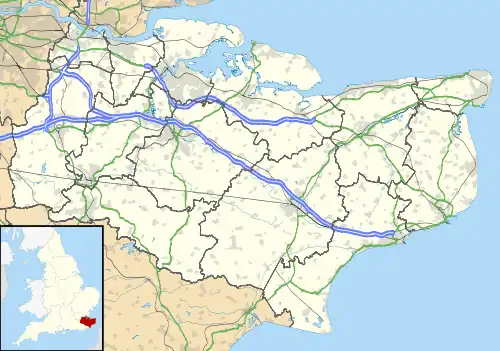| Fordwich | |
|---|---|
 | |
 Fordwich Location within Kent | |
| Area | 1.81 km2 (0.70 sq mi) |
| Population | 381 (civil parish 2011)[1] |
| • Density | 210/km2 (540/sq mi) |
| OS grid reference | TR179597 |
| • London | 65.8 miles |
| Civil parish |
|
| District | |
| Shire county | |
| Region | |
| Country | England |
| Sovereign state | United Kingdom |
| Post town | CANTERBURY |
| Postcode district | CT2 |
| Dialling code | 01227 |
| Police | Kent |
| Fire | Kent |
| Ambulance | South East Coast |
| UK Parliament | |
Fordwich /ˈfɔːrdwɪtʃ/ is a market town and a civil parish in east Kent, England, on the River Stour, northeast of Canterbury.
It is the smallest community by population in Britain with a town council.[2] Its population increased by 30 between 2001 and 2011.[1]
History
Fordwich is listed in the 1086 Domesday Book as a small village.[3] The town grew in the Middle Ages as a port for boats on their way upriver to Canterbury. All of the Caen stone used by the Normans to rebuild Canterbury Cathedral in the 12th and 13th centuries was landed at Fordwich. It later became a limb of the Cinque Ports. It lost its status as a town in 1880 when it no longer had a Mayor and Corporation. However, in a reorganisation in 1974, Fordwich was again made a town. Fordwich Town Hall was rebuilt in or shortly before 1544.[4]
The ancient Church of St Mary the Virgin, now redundant but open to the public, and in the care of the Churches Conservation Trust, contains part of a carved sarcophagus reputed to have contained the remains of St Augustine of Canterbury.[5] The 16th-century building next the Town Hall, now known as Watergate House, was the family home of John and Gregory Blaxland, early 19th-century pioneers of Australia.[6]
Palaeolithic archaeology
During the 1920s-1930s, a significant amount of Palaeolithic handaxes were discovered during industrial quarrying to the west side of Fordwich. In total, these handaxes numbered some 330 pieces, along with flakes from lithic construction. [7] During 2020, Cambridge University dug exploratory trenches at the same western location, discovering deposits of Palaeolithic archaeology, counting 251 in-situ Lower-Palaeolithic flakes and scrapers from Acheulean industry. [8] In 2022, Archaeologist Peter Knowles [Professor David Bridgland [9] Professor, Archaeology, Mark White [10] ] of Durham University made a handaxe discovery from an area called Moat Rough in Fordwich. Moat Rough is of particular interest archaeologically because the ground there has been left fallow for decades with no quarrying or development. The new handaxe discovery at Moat Rough revealed that gravel terraces bearing Palaeolithic archaeology running underneath Fordwich are much more widespread than previously thought, indicating that there is much more research on early-man that needs to be done there.
Community

There are two pubs in the town, the George & Dragon and Fordwich Arms, which boasts a Michelin star. Fordwich gained angling and fishing repute from Izaak Walton for its "Fordidge trout", one of the largest types found.[11]

See also
- Broughton in Furness with as few as 529 residents
- Stockbridge in Hampshire, with a population of 592
- Manningtree in Essex, another claimant for smallest town in England, with 700 people in 20 hectares
- Llanwrtyd Wells in Wales, another claimant for smallest town in Britain, has a population of 850
References
- 1 2 Key Statistics; Quick Statistics: Population Density Archived 20 October 2016 at the Wayback Machine United Kingdom Census 2011 Office for National Statistics Retrieved 14 October 2016
- ↑ Matthews, Peter (1992), The Guinness Book of Records, 1993, Guinness World Records Limited, ISBN 978-0-85112-978-5
- ↑ Open Domesday Online: Fordwich Archived 14 January 2019 at the Wayback Machine, accessed January 2019.
- ↑ Archaeologia Cantiana. Vol. 112. Kent Archaeological Society. 1994. p. 116.
- ↑ St Mary's Church, Fordwich, Kent: A walk round guide (PDF), Churches Conservation Trust, archived from the original (PDF) on 9 October 2012, retrieved 2 April 2011
- ↑ "A picture-perfect retreat from the world, in an ideal spot in England's smallest town". Country Life. 14 September 2018. Retrieved 8 September 2021.
- ↑ Murugesu, Jason Arunn. "UK's earliest hand axes were made by ancient humans 560,000 years ago". New Scientist. Retrieved 21 February 2023.
- ↑ Key, Alastair; Lauer, Tobias; Skinner, Matthew M.; Pope, Matthew; Bridgland, David R.; Noble, Laurie; Proffitt, Tomos (June 2022). "On the earliest Acheulean in Britain: first dates and in-situ artefacts from the MIS 15 site of Fordwich (Kent, UK)". Royal Society Open Science. 9 (6): 211904. doi:10.1098/rsos.211904. ISSN 2054-5703. PMC 9214292. PMID 35754990.
- ↑ University, Durham. "Professor David R. Bridgland - Durham University". www.durham.ac.uk. Retrieved 21 February 2023.
- ↑ University, Durham. "Professor Mark White - Durham University". www.durham.ac.uk. Retrieved 21 February 2023.
- ↑ Izaak Walton (1653). "Chapter 4 Observations of the nature and breeding of the Trout, and how to fish for him. And the Milk-maids Song.". The Compleat Angler. ISBN 978-1500247553.
